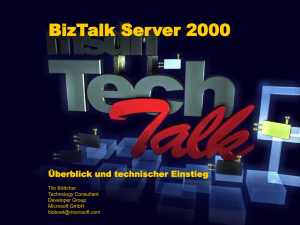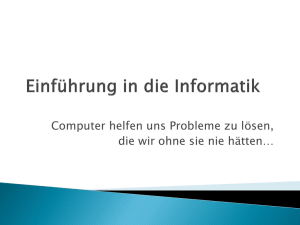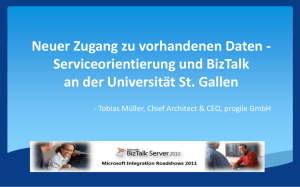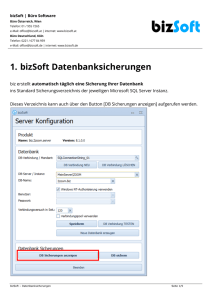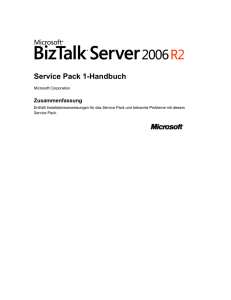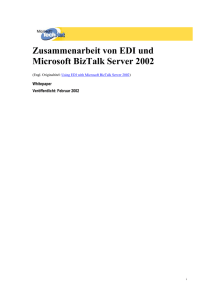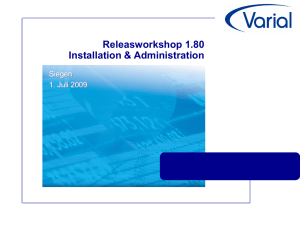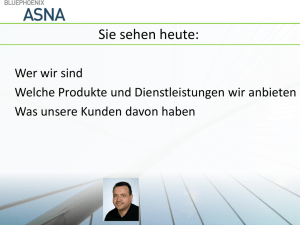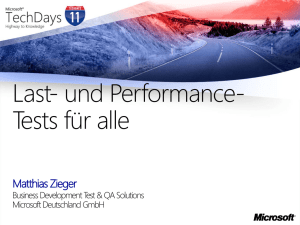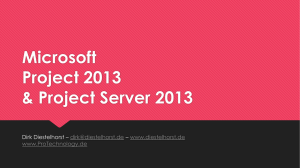presentation
Werbung
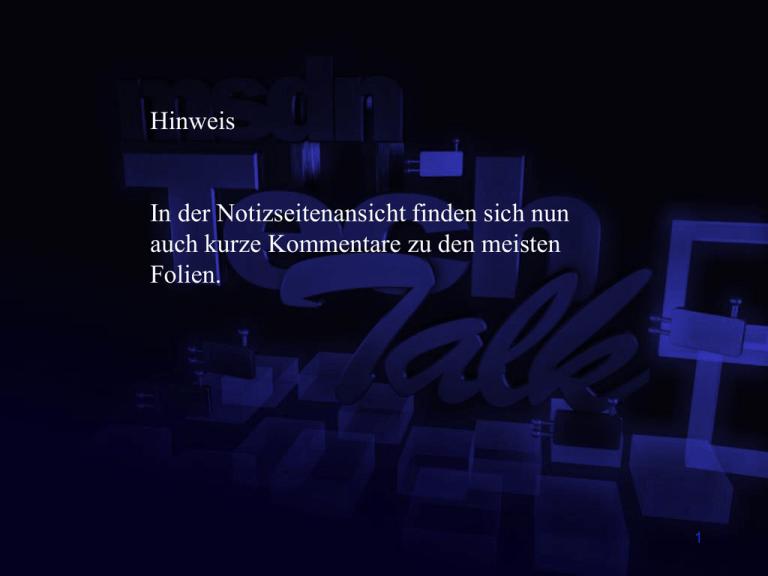
Hinweis In der Notizseitenansicht finden sich nun auch kurze Kommentare zu den meisten Folien. 1 BizTalk Server 2000 Überblick und technischer Einstieg Tilo Böttcher Technology Consultant Developer Group Microsoft [email protected] Frank Lange System Engineer Developer Group Microsoft [email protected] Microsoft BizTalk Server 2000 – Überblick und technischer Einstieg Im Mittelpunkt dieses TechTalks steht die Frage, wie Sie Geschäftsprozesse auf der Basis von strukturierten (XML) Dokumenten mit Hilfe der Werkzeuge des BizTalk Servers 2000 modellieren, programmieren und verarbeiten können. Besondere Aufmerksamkeit soll dabei der Festlegung und dem manuellen sowie funktionsorientierten Mapping von Schemata gelten. Stichworte wie Transaktionen, Parallelisierung und Fehlerbehandlung sollen skizziert und ein Exkurs in die Business-Prozess Design- und Entwicklungsumgebung unternommen werden. Angesprochen ist der technisch orientierte Business Prozess Analyst ebenso wie der Programmierer von Komponenten und Geschäftsanwendungen. 3 Inhalt dieses TechTalk Funktionsweise und Aufgaben des BizTalk Servers Dokumentenaustausch Integration von Applikationen Wo ist der Developer gefragt?? Demos!! 4 Agenda BizTalk Initiative BizTalk Server Management der Handelspartner Dokumenten Mapping und Anpassung Dokumenten Routing und Zustellung Integration von Applikationen 5 BizTalk Initiative XML wird als DAS Format zum Dokumentenaustausch im Inter-/Intranet angesehen. Firmen stellen Ihre branchenspezifischen XML-Schemata bereit, andere können diese als Vorlage hernehmen. SW-Hersteller liefern Tools und Anwendungen für den Umgang mit XML. 6 BizTalk Framework Veröffentlichen vorhandener Schemata Erstellung neuer Schemata P&G Planung der Zusammenarbeit Merisel High-Tech Distribution FDC/Citigroup TransPoint Internet Abrechnung Tools für die Erstellung von Biztalk Apps zur Verfügung stellen Verwaltung unter http://www.biztalk.org 7 BizTalk Community www.biztalk.org Web basierte Schema Bibliothek Tools für die Registrierung und das Tracking von Schemata 300+ 3rd Party XML Schemata 150+ Registrierte Organisationen 8 Visual Studio Microsoft und BizTalk BizTalk Server 2000 Visio 2000 SQL 7/2000 Windows 2000 Server Windows 2000 (XML/XSL) Visio 2002 wird XML Formate haben BizTalk Server 2000 Visual Studio 6 / VS.NET Commerce Server 2000 9 Agenda BizTalk Initiative BizTalk Server Management der Handelspartner Dokumenten Mapping und Anpassung Dokumenten Routing und Zustellung Integration von Applikationen 10 Kommerzielle B2B Szenarien Die wichtigsten Commerce Szenarien heute: Zusammenführung von Handelspartnern Automatisierte Abrechnung B2B Portale/Extranets Integration von Business Prozessen Zukunftsaspekte XML als W3C Standard gewinnt Bedeutung Der Weg hin zu XML wird leichter WebServices basieren auf XML 11 Beispiel: Marks and Spencer Projekt 35 Mio Docs/Tag -> 400 Docs/sec, ca. 600 Geschäfte weltweit Lager/ Laden zentrale Windows 2000 Umgebung S/390 Umgebung data MESSAGING HUB COM-TI CICS DB2 Database data XML MSMQ/ MQ Series MQ Series Model Bridge 204 APPLICATION MSMQ BizTalk doc Transactions wrapped in XML •BizTalk Server •MSMQ •Windows 2000 BizTalk doc MSMQ MSMQ SQL Database NT Umgebung 12 Demo (Verwaltung: Tools und Dienste) BTS Messagingdienste (Dienste auf dem Rechner) XLANG Scheduler (COM+ App, Komponentendienst) BTS-Administratorgruppe BTS-Verwaltung (BT-Servergruppen) SQL-Server DBs im Hintergrund WebDAV (XML-Schemata- und Mapping-Reopsitory) 13 Fähigkeiten des BizTalk Servers Firma A Trading Profiles Firma B Bestellung Rechnung Trading Profiles Management von Handelspartnern Dokumenten Mapping und Anpassung Dokumenten Routing und Zustellung Integration Extraktion SQL von Applikationen und Analyse von Daten 14 Demo (Messaging Dienste) Organisation „RechnungsGmbH“ XML-Schemata: Bestellung, Rechnung XML-Konvertierung (Mapping) XML-Dokumentendefinition (in die DB) Port zum „Rechnungsotto“ (z.B. Filetransport) Kanal zum Port: Bestellung rein, Rechnung raus Dateiempfangsfunktion: speisen des Kanals Dokumenten-Tracking 15 BizTalk Server Key Features (I) Management von Handelspartnern Organizationen Vereinbarungen Kommunikations-Ports und Kanäle (Channels) Dokumenten Mapping und Anpassung XML basiert EDI – X12 und EDIFACT Flat Files – getrennt/feste Länge 16 BizTalk Server Key Features (II) Zuverlässiges Routing und Zustellung von Dokumenten Unter Nutzung verschiedener Internet Protokolle: • HTTP, HTTPs,SMTP, DCOM, File, MSMQ Empfangen von Applikationen Direkte Integration Generische Integration Extraktion und Analyse von Daten Dokumenten Tracking Logs über Aktivitäten 17 Benutzung der Windows 2000 Services Fehlertoleranz und Skalierbarkeit Benutzung der Load Balancing und Clustering Services Sicherheit Benutzung der Public Key Infrastruktur Einfache Administration Mit dem Windows Management Interface Active Directory (optional) Ablage von Handelspartner-Zertifikaten (nur einmal notw.) Sicherheitsprinzipien im AD können auf Partner gemapped werden 18 Features Visual Studio BizTalk Server Versionen BizTalk Server 2000 Visio 2000 SQL 7/2000 Windows 2000 Server Standard Enterprise Developer Processor Support One unlimited unlimited Scale-out clustering None unlimited unlimited Failover clustering None unlimited** unlimited** Trading Partners 5 max. unlimited unlimited Internal Applications 5 max. unlimited unlimited No Yes Yes SDK 19 BizTalk Server Installationsvoraussetzungen Hardware: An Intel® Pentium 300 processor. 128 megabytes (MB) of RAM. 6-gigabyte (GB) hard disk. CD-ROM drive. network adapter card. VGA or Super VGA monitor. Microsoft Mouse or compatible pointing device. Software: Complete installation Microsoft Windows 2000 Server, Microsoft Windows 2000 Advanced Server, or Microsoft Windows 2000 Professional with the NTFS file system and Service Pack 1 Microsoft Internet Explorer 5 or later Microsoft Visio® 2000 SR-1A or later (required to use BizTalk Orchestration Designer) Microsoft SQL Server™ 7.0 and SQL Server Service Pack 2 (SP2) or SQL Server 2000 Tools installation Microsoft Windows 2000 Server, Microsoft Windows 2000 Advanced Server, or Microsoft Windows 2000 Professional with the NTFS file system and Service Pack 1 Microsoft Internet Explorer 5 or later Microsoft Visio 2000 SR-1A or later (required to use BizTalk Orchestration Designer) Custom installation Microsoft Windows 2000 Server, Microsoft Windows 2000 Advanced Server, or Microsoft Windows 2000 Professional with the NTFS file system and Service Pack 1 Microsoft Internet Explorer 5 or later Microsoft Visio 2000 SR-1A or later (required to use BizTalk Orchestration Designer) Microsoft SQL Server 7.0 and SQL Server Service Pack 2 (SP2)* or SQL Server 2000 20 Agenda BizTalk Initiative BizTalk Server Management der Handelspartner Dokumenten Mapping und Anpassung Dokumenten Routing und Zustellung Integration von Applikationen 21 Handelspartner Profile Port „A“ Inbound Agreement Application „Source“ Port „B“ Outbound Agreement Channel Organisation „My Org“ Application „Destination“ XXX XXX Document Definition 22 BizTalk Messaging Manager Definition von Organizationen und Applikationen Definition von Vereinbarungen Anlegen von Quelle/Ziel Eingang/Ausgang Dokumenten Definitionen Sicherheit Definition von Nachrichten-Ports und Kanälen Mapping 23 BizTalk Editor Erstellen und Speichern von XML Schemata Export der BizTalk XDR Syntax (XML reduced) Import Module für WellFormed-XML DTD XDR Schema Benutzung für XML/Non-XML X12 EDI Flat (Delimited & Positional) 24 Agenda BizTalk Initiative BizTalk Server Management der Handelspartner Dokumenten Mapping und Anpassung Dokumenten Routing und Zustellung Integration von Applikationen 25 BizTalk Mapper Mapping zwischen XML Schemata als XDR Schema speichern Breite Palette an Möglichkeiten Functoids Script Compilierung und Test der Maps 26 Vielzahl an Transportmöglichkeiten und Formaten EDI DCOM MSMQ HTTP ADO XML BizTalk Server SMTP HIS Server File System XML SAP IDOC 27 Mapping und Anpassung von Dokumenten Beispiel 1: XML zu XML XML Document XSL Engine XML Document XSL Map Beispiel 2: EDI zu Flat File EDI Document Data Parser XML Schema XML Document XSL Engine XSL Map XML Document XSL Engine Flat File Document XSL MAP 28 Agenda BizTalk Initiative BizTalk Server Management der Handelspartner Dokumenten Mapping und Anpassung Dokumenten Routing und Zustellung Integration von Applikationen 29 BizTalk Architektur Wenn beide Partner BTS einsetzen, dann ist XML das beste Austauschformat. Organisation B Organisation A Application BizTalk Server Application Internet XML Output Data Communication BizTalk Message – XML based BizTalk Server XML Input Data Communication 30 Agenda BizTalk Initiative BizTalk Server Management der Handelspartner Dokumenten Mapping und Anpassung Dokumenten Routing und Zustellung Integration von Applikationen 31 Senden und Empfangen von Dokumenten Senden von Dokumenten zum BizTalk Server Direkte Integration Generische Integration Empfang von Doks vom BizTalk Server File, MSMQ, HTTP Application Integration Component(s) 32 Direkte Integration VB-Applikation, ASP-Seite Sendende Applikation BizTalk Server IInterchange:submit (1,Document,,,,, Pipeline,Sender,Receiver) Direkte Integration: Funktionen von IInterchange Submit() für asynchrone Kommunikation SubmitSync() für synchrone Kommunikation 33 Generische Integration Sendende Applikation Empfangender BizTalk Server Funktion für Dateiempfang Verzeichnis Generische Integration durch die empfangende Funktion Datei, FTP, MSMQ 34 Application Integration Components IPipelineComponent:Execute Biztalk Server 2000 Doc Doc … Doc AIC Submitted Business document 35 Demo: Fallbeispiel mit dem MS internen eProcurement System MS Market Scenario Kauf eines Laptops mit Microsoft´s internem Bestellsystem MS Market 36 Case Study: MS Market Business Process User Actions Roles PO Invoice MS Market Finance Supplier Reviewer Shipper Approver Approver Purchase request PO request approval PO approval Purchase order Purchase order acknowledgement Configuration Review Purchase confirmation and ETA Shipping order Invoice Invoice request approval Invoice approval Payment 37 Case Study: MS Market Dokumente, Schemata und Transportwege Document Transport MS Market Supplier PO EDI VAN Delimited Flat File X12-850 PO PO Ack. EDI VAN X12-855 PO X12-855 PO Invoice FTP SAP I-DOC X12-810 Inv. Payment EDI VAN EFT / EDI EFT / EDI 38 Case Study: MS Market Technische Anforderungen B2B Integration (Business-to-Business) A2A Integration (Application-to-Application) Zusammenspiel und Workflow 39 Case Study: MS Market B2B Integration Microsoft User Invoice PO MS Approver Approver Market Supplier Finance Supplier Reviewer Shipper Purchase Request PO Request Approval PO Approval PurchaseOrder Configuration Review Purchase Confirmation and ETA Shipping Order Invoice Invoice Request Approval Invoice Approval Payment 40 Case Study: MS Market B2B Integration Microsoft User Invoice PO MS Approver Approver Market Supplier Finance Supplier Reviewer Shipper Purchase Request PO Request Approval PO Approval PurchaseOrder Configuration Review Purchase Confirmation and ETA Shipping Order Invoice Invoice Request Approval Invoice Approval Payment 41 Case Study: MS Market B2B Integration Microsoft Customer Inacom Supplier Purchase Order PO Confirmation and ETA Invoice Payment 42 Case Study: MS Market Application-to-Application Integration Microsoft (Customer) Send PO PO Receive Confirmation Conf & ETA Receive Invoice Invoice Send Payment PO PO Confirmation and ETA Invoice Payment Payment 43 Demo (Orchestration Designer) Bestellung erhalten (via MessageQueue) Entscheidung: ob Akzeptanz (XML-Feldabfrage) Bestellung weiterleiten (via COM) Rechnung schicken (Kanal Rechnungsotto) Triggerung z.B. vom WebService - oder hier einfache VB-EXE. 44 Links BizTalk Infos: http://www.microsoft.com/biztalk XML, XML-Schema, BizTalk Framework http://msdn.microsoft.com/xml http://msdn.microsoft.com/xml/XMLGuide/schemaoverview.asp BizTalk.org, Infos, Community und Schemata http://www.biztalk.org BizTalk Server 2000 Enterprise http://www.microsoft.com/biztalkserver 45 Fragen? 46 Glossar AIC – Application Integration Component: Definierte Programmierschnittstelle für den Zugriff auf Systemfunktionen ASP - Application Service Provider ASP heißt, dass der Kunde seine Programme, Standardanwendungen und Speziallösungen über das Netz aus einem zentralen Rechenzentrum bezieht. Die IT-Kosten werden so für Ihr Unternehmen zum ersten Mal transparent und genau kalkulierbar. EDI – Electronic Data Interchange For Administration Commerce and Transport" • Gemeint ist damit ein Standard, den die Vereinten Nationen für die elektronische Abwicklung geschäftlicher Vorgänge zwischen Unternehmen, Branchen und Ländern entwickelt haben ERP - Eine Abkürzung für Enterprise Resource Planning Systeme, die es Organisationen erlauben, Ressourcen unternehmensweit zu verwalten und gleichzeitig Herstellungssysteme ganz zu integrieren XML - eXtensible Markup Language: Textbasiertes, allgemeines Datenformat, das Grundregeln für den Aufbau eigener Datenformate definiert. XSL - XML Stylesheet Language: XML-basierte Sprache, mit der Transformationen von XML-Daten definiert werden können. 47 BizTalk Server Terminologie und Akronyme ACH Automated Clearinghouse ACID Atomic, Consistent, Isolated, Durable ADCU Applications Developer Customer Unit ADO Active Directory Object AIAG Automotive standard within ANSI X12 ANSI American National Standards Institute APO Advanced Planning and Optimization ASC Accredited Standards Committees (within ANSI) ASN Advanced Ship Notice ATL Active Template Library ATM Asynchronous Transfer Mode B2B Business to Business B2C Business to Consumer B3 Baan Business Bus BDO Business Document Object BDSE Business Document Specification Editor (CIS) BOI Business Object Interface BOM Bill of Materials CA Certificate Authority CIP Commerce Interchange Pipeline CIP Common Indexing Protocol CIPM Commerce Interchange Pipeline Manager CIS Commerce Interchange Server (Latinum) CORBA Common Object Request Broker Architecture CRL Certificate Revocation List CS Commerce Server (Plutonium) CSF Content Selection Framework DAV Distributed Authoring & Versioning (see WebDAV) DCD Document Content Description DEM Dynamic Enterprise Model DES Data Encryption Standard DHCP Dynamic Host Control Protocol DIB Directory Information Base DISP Directory Information Shadowing Protocol DIT Directory Information Tree DNS DNS DOM DSA DSO Digital Nervous System Domain Name System Document Object Model Digital Signature Algorithm Data Source Object DSP Directory System Protocol DSS Digital Signature Standard DTD Document Type Definition EAI Enterprise Application Integration EDI Electronic Data Interchange EDIFACT Predominant EDI standard supported by UN EDIINTEDI over the Internet EFT Electronic Funds Transfer EMPI Enterprise Master Person Index ERP Enterprise Resource Planning FA Functional Acknowledgement (997) GTDI Guide for Trade Data Interchange – a set of standards published by UN/EDIFACT ICE Information and Content Exchange ICMP Internet Control Message Protocol IDEA International Data Encryption Algorithm IETF Internet Engineering Task Force ILS Internet Locator Service IM Interchange Manager (BizDesk Module) ISAKMP Internet Security Association and Key Management Protocol ISO/OSI International Organization for Standardization Open Systems Interconnection (data communications model) KEA Key Exchange Algorithm Kerberos Protocol developed by MIT, provides 3 levels of security protection LCE Loosely Coupled Events (COM+) LDAP Lightweight Directory Access Protocol LOB Line of Business MDN Message Disposition Notification MDN Message Disposition Notification MMC Microsoft Management Console MOET Microsoft Order Entry Tool MOM Message-oriented Middleware MRP Manufacturing Resource Planning MTBF Mean Time Between Failures NACHA National Automated Clearing House Association NNTP Network News Protocol NSA National Security Agency NT SSPI NT Security Service Provider Interface OAGIS Open Applications Group Integration Specification OBI Open Buying on the Internet OLAP Online Analytical Processing OPA Online Privacy Alliance ORB Object Request Broker PAEB PCT PFM PFX PKCS Pan American EDIFACT Board – U.S. reps to UN/EDIFACT Private Communications Technology Personal Finance Manager Personal Information Exchange Public Key Cryptography Standards PKI Public Key Infrastructure POC Proof of Concept POR Plan of Record RDF Resource Description Framework Resource Manager Any controller of a transacted resource, such as SQL Server, that participates in distributed. The term comes from the X/Open consortium in their work on transactional protocols. RFC Remote Function Call SAP Systems, Applications, and Projects in Data Processing (Sap Aktiengesellschaft) SET Secure Electronic Transaction SFA Sales Force Automation SHA Secure Hash Algorithm SOAP Simple Object Access Protocol SOAP Simple Object Access Protocol SS Site Server SSL Secure Sockets Layer STM Synchronous Transfer Mode STP Straight Through Processing TCO Total Cost of Ownership TDCC Transportation Data Coordinating Committee TIP Transactional Internet Protocol – developed jointly by MS and Tandem. It’s a relatively lightweight 2-phase commit protocol that operates between multiple potentially dissimilar Resource Managers to ensure distributed transactions with all the desired ACID properties. TTL Time-to-live UCS Uniform Communications Standard, the Grocery standard within ANSI X12 UDP User Datagram Protocol VAN Value Added Network VCI Value Chain Initiative (Microsoft) VICS Voluntary Inter-Industry standard within ANSI X12 W3C World Wide Web Consortium WBEM Web-based Enterprise Management -- integrating Internet compatibility and system management independent of vendor, protocol, or management standards. WebDAV Distributed Authoring and Versioning (set of verbs and syntax for HTTP, embodies the set of operations needed to author and manage documents) X12 Predominant EDI standard in USA (all of the communicationsrelated standards committees within ANSI have names XML eXtensible Markup Language XQL XML Query Language XSL eXtensible Style Sheet Language 48 Die Vision von Microsoft Empower people through great software any time, any place, and on any device 49 This presentation is for informational purposes only. MICROSOFT MAKES NO WARRANTIES, EITHER EXPRESS OR IMPLIED, IN THIS PRESENTATION. ©2000 Microsoft Corporation. All rights reserved. Microsoft, ActiveX, BackOffice, the BackOffice logo, FrontPage, Microsoft Internet Explorer logo, Visual Basic, Visual C++, Visual FoxPro, Visual InterDev, Visual J++, Where do you want to go today?, Win32, Windows, the Windows logo, the Windows Start logo, and Windows NT are either registered trademarks or trademarks of Microsoft Corporation in the United States and/or other countries. Other products and company names mentioned herein may by the trademarks of their respective owners.

